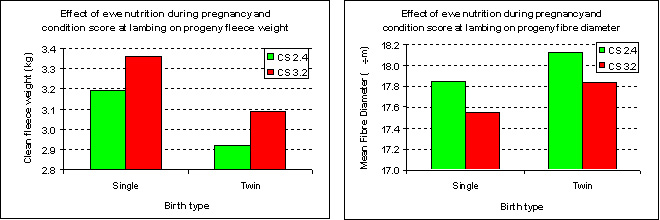|

Production from ewes and
their progeny can be
predicted with confidence
from knowledge of the ewe
Condition Score (CS)
profile. The profile sets
the CS targets for key times
during the reproductive
cycle. Ewe CS at joining and
at lambing set the framework
of the profile and the
environmental conditions,
including expected level of
pasture available in
late-pregnancy, dictate the
shape of the profile for a
particular region. Twinning
ewes have some special
considerations.
How much extra effort you
spend on managing twins will
depend on your objectives
and what proportion of the
flock are twinners.
Twinning rate is dependant on
condition
of the ewe at
joining (and flocks
have different responses).
Better condition means
higher proportion of
twinners (up to 45 extra
foetuses per 100 ewes with
each condition score
increase).
Once ewes are identified with
twins, there are good
opportunities to manage them
for higher production
(survival, birth weight and
wool production). Selective
feeding twin ewes over
single ewes may mean no
increase in total feeding
for the flock but
significant increases in
production.
Effect on Progeny Wool
Production
Good ewe condition by lambing
impacts on twin lamb wool
production by increasing CFW
by up to 0.3kg and
decreasing fibre diameter by
0.15µm.

Effect on Lamb
and Ewe Survival
Twin ewes are more prone to
higher mortality at lambing,
particularly when conditions
are poor or the ewes are
older. Twinners should
be at least CS 3 and on good
pasture to allow
unrestricted intake by
lambing to limit pregnancy
toxaemia. Older ewes (full
mouth and older) should have
higher FOO @ lambing to
ensure adequate intake.
Twin lambs generally have
poorer survival and lower
birth weights. Improving
condition of the ewe prior
to lambing has a large
impact on twin survival (up
to 20% increase per
condition score of the ewe).
Guidelines
- Twin ewes should be at
least 2.7 CS, preferably
3.2 CS by lambing
- Any ewe < CS2 should
be removed from the mob
and managed
separately
- Provide adequate intake
and maintain good
condition prior to
lambing to avoid
pregnancy toxaemia
- Provide pasture to meet
targets for twin bearing
ewes and good shelter.
Twin lamb survival is
very affected by poor
weather
- If there is no
opportunity to gain
condition in late
pregnancy on green
pasture then maintain
ewe condition throughout
all of pregnancy
At pregnancy
scanning (day 90)
- If ewes are < CS 2.7,
twinners require 1000
FOO of good quality
green feed to allow good
gains prior to lambing.
If no green feed
available, maintain CS
through supplementation
- If ewes are > CS 2.7,
twinners require 900 FOO
to have a small gain by
lambing.
- If < CS 2.5 then
supplementary feed to
gain condition to 2.5 CS
by lambing
By lambing
- Separate twinners from
singles, allowing
twinners to have the
most sheltered paddock
and >1800 FOO. If no
green feed then ensure
25MJ/h/d to maintain
over peak lactation
- Twin ewes should be CS
3.2 by lambing for
optimum production
Danger Zone
Twin ewes < CS 2.5 @
lambing,
Single ewes
<CS 2 or >CS 4 @
lambing
Options:
- Identify twinners (with
option to run separately
in late pregnancy) and
remove dries @ scanning
(d 90)
- Draft off any twinners
< CS 2.5 @ day 90 and
manage separately to
increase Condition Score
- Draft off any single
ewes < CS 2 @ day 90
and manage separately to
increase Condition Score
- Prepare lambing paddocks
- especially twinner mob
by:
o Controlling
predation
o Providing
shelter
o Good
quality and supply of
pasture
- Any ewes <CS 2 should
be removed from the mob
and managed separately
Back to
Top
|